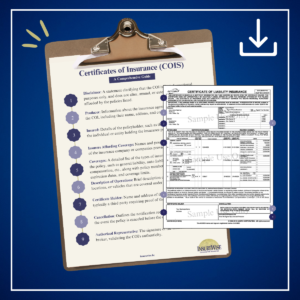- January 2, 2024
- Posted by: Rachel DeLaune
- Categories: Blog, Video

The Importance of Insurance Documentation
Understanding and utilizing Certificates of Insurance (COIs) and Subcontractor Agreements can be the difference between smooth sailing and turbulent waters for your business.
Understanding Certificates of Insurance (COIs)
A Certificate of Insurance (COI) is essentially the ID card for your business insurance. It displays your insurance coverage, detailing critical information such as policy type, number, coverage period, and limits. This document is crucial when you’re hiring subcontractors or when clients need confirmation of your insurance coverage.
Think of a COI as the equivalent of being pulled over by the police and asked to show your insurance ID card. It’s a means of verifying your insurance coverages.
When a client requests your COI, you’ll need to provide your insurance agent with necessary details to ensure accurate and prompt delivery; such as the client’s:
- Business Name
- Business Address
- Contact Person
- Email Address
- Any contracts you have or will sign with the client: your agent will review these to confirm your policies meet all insurance requirements.
Your agent will populate the COI, then send it directly to the recipient, usually via email.
This direct approach ensures the COI’s authenticity and alleviates insurance fraud.
Not sure how to read a COI? Download our Comprehensive COI Guide to learn how.
The Role of Subcontractor Agreements
Now, let’s dive into subcontractor agreements. Imagine you’re a general contractor building a new home and you hire a roofer to install the roof. Months later, the house is finished, but after a night full of rain and wind, the roof leaks and causes property damage to the floors and walls. Now the homeowners are suing YOU for the damages. Seems unfair, right!? You didn’t even perform the work! This is where a well-crafted subcontractor agreement becomes invaluable.
A subcontractor agreement is a legally binding contract between the General Contractor and the Subcontractor hired to complete work on the General Contractor’s behalf. When properly written and executed, it clarifies that any damages or injuries caused by the subcontractor’s work are their responsibility. This agreement is your shield against unfair liabilities and ensures everyone performing work understands their roles and responsibilities.
Contractual Risk Transfer (CRT)
Contractual Risk Transfer is a risk management strategy that contractually shifts the financial responsibilities from one party to another. By having a signed subcontractor agreement before any work starts, you’re legally shifting the risk to the party actually performing the work. It’s a strategic move to avoid the metaphorical “liability hot potato.” In order for the subcontractor agreement to do this successfully, it needs to have 5 key elements.
Without this executed contract, your company could be on the hook for any claims and damages arising from injuries or loss due to the subcontractor’s work!
Safeguarding Your Business
In the realm of commercial insurance, being proactive with COIs and subcontractor agreements BEFORE work begins is not just good practice; it’s essential for protecting your business from unforeseen risks. These documents ensure clarity, responsibility, and protection, allowing you to focus on what you do best – running your business.
Lets ensure your business is prepared for whatever comes its way! Contact Us.
Related Content: Key Ingredients for Effective Subcontractor Agreements

